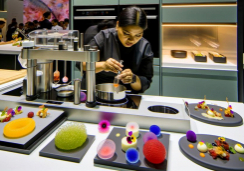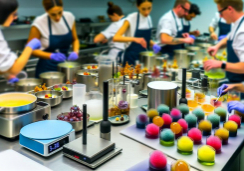What Makes a Great Gluten-Free Baking Recipe?
You sift, you mix, you bake; but when you substitute gluten-free flours in your favorite recipes, you're often met with a challenge that goes beyond simple measurements.
As you embark on your gluten-free baking journey, you'll soon discover that the secret to a great recipe isn't just about finding the right substitutes—it's about understanding how these ingredients interact to create textures and flavors that are both delightful and familiar.
You must navigate a maze of alternative flours, each with its own unique properties, and learn how to pair them with the right binders and leavening agents.
But what really elevates a gluten-free bake from good to great? The answer lies in the delicate balance of science and art, a harmony of ingredients that ensures each bite is as satisfying as its gluten-rich inspiration.
Stick around, as we're about to uncover the pillars that support the most successful gluten-free baked creations, and perhaps you'll find the keys to unlock the full potential of your flour power.
Ingredient Substitutions
Embarking on the adventure of gluten-free baking, you'll find that clever ingredient swaps like incorporating xanthan gum or adjusting egg proportions can significantly enhance the texture and structure of your creations. Unlike traditional wheat flour, which naturally contains the binding protein gluten, gluten-free flours often require a substitute to mimic its properties. Xanthan gum emerges as a hero in this scenario – a thickener, emulsifier, and stabilizer all in one. It's the secret to preventing your muffins and cakes from crumbling into a disappointing pile of crumbs.
When dealing with wet batters, remember that eggs can be your ally. You can replace half the liquid by weight with eggs for a better rise and a more tender crumb. For drier mixtures like those in scones and cookies, adding an extra egg, rather than substituting, provides the additional moisture needed without sacrificing flavor.
As the liquid content increases, so does the need for structural support from xanthan gum and eggs. It's all about balance – too little and your cake won't hold, too much and it becomes gummy. Precision in your experimentation is key, with each adjustment bringing you closer to a nutritious, innovative, and delectable gluten-free treat.
Texture Considerations
Navigating the realm of gluten-free baking, you'll quickly learn that achieving the perfect texture is as important as the flavor of your finished product. The absence of gluten, which offers elasticity and structure, means that you must find innovative ways to replicate these qualities to satisfy your palate's desire for that familiar consistency.
Almond flour, with its rich, buttery profile, can impart a delicate crumb to your cakes and cookies. But it's not just about swapping in GF flour; it's about understanding the properties of each flour to harness their potential for your culinary creations. Coconut flour, for instance, is highly absorbent and can yield a drier texture, requiring adjustments to moisture levels in your recipes.
Eggs and xanthan gum are your allies in this quest for the right mouthfeel. They bind ingredients, mimicking gluten's role, to provide structure and elasticity. Your baked goods need not crumble at a touch when these elements are carefully balanced.
To master texture, you must be willing to experiment. Blend different GF flours, tweak ratios, and refine your techniques. Remember, each adjustment brings you closer to that elusive, nutritious perfection, where every bite is a testament to your dedication to the gluten-free craft.
Flavor Pairings
While exploring gluten-free baking, you'll discover that the art of flavor pairing is essential for creating delectable treats that delight the senses. Transform classic chocolate chip cookies by introducing the nutty richness of peanut butter, ensuring a taste that's both familiar and refreshingly new. This dynamic duo isn't only flavorful but also nutritious, offering a good source of protein and heart-healthy fats.
Venture beyond the basics by mixing tart seasonal fruits like cherries with the deep, indulgent notes of dark chocolate for a balanced fusion that sings in every bite. Or, consider the tropical flair of coconut paired with the subtle sweetness of almond, a combination that adds an innovative twist to your gluten-free confections.
Don't shy away from enhancing your recipes with spices that evoke the warmth of the seasons. A dash of cinnamon paired with the earthy sweetness of pumpkin can elevate your autumnal bakes to new heights. For a truly sophisticated palate, integrate unexpected elements such as a hint of espresso powder to deepen the flavor profile of your desserts, or red wine cherries that contribute both a tangy kick and a touch of elegance.
Recipe Testing
You'll find that perfecting gluten-free baked goods is an iterative process, where each trial brings you closer to a delightful balance of flavors and textures. Consider the interplay between your chosen gluten-free flours and other ingredients to achieve the ideal crumb and taste.
Iterative Process
To perfect your gluten-free baking recipes, embrace the iterative process. Each test run fine-tunes the balance of flavor, texture, and appearance through careful adjustments and documentation. This structured approach is key to creating delicious, reliable gluten-free treats.
Here's how you can make the most of it:
- Begin by assessing your initial outcome; identify what works and what doesn't.
- Make one change at a time to isolate variables effectively.
- Document each alteration meticulously to track your progress.
- Utilize feedback to guide your next iteration, honing in on perfection.
- Repeat the process until you reach the pinnacle of gluten-free excellence.
Flavor and Texture Balance
Having embraced the iterative process, it's now time to focus on fine-tuning flavor and texture, as these elements are pivotal in crafting gluten-free baked goods that truly satisfy.
Your quest for a moist, tender crumb in gluten-free banana bread hinges on the meticulous blending of gluten-free flours. Each flour contributes distinct notes, from nutty to sweet, enhancing the overall profile. It's not just about substituting ingredients; it's about reimagining the interplay between them.
Binders and leavening agents are your allies in achieving that coveted rise and perfect crumb. Through rigorous recipe testing, you'll discover the precise ratios that yield a nutritious, innovative banana bread that resonates with the richness you adore.
What Are Some Essential Ingredients for Creating Gluten-Free Baking Recipes?
When it comes to creating delicious gluten-free baking recipes, it’s essential to have the right ingredients. Stock up on gluten-free flours like almond, coconut, or rice flour. Other must-haves include xanthan gum, gluten-free baking powder, and alternative sweeteners like maple syrup or honey. Happy glutenfree baking recipes creating!
Nutritional Balance
As you explore gluten-free baking, it's vital to consider the nutrient content of your ingredients. You'll want to balance your macronutrients—ensuring you're getting enough protein, fats, and complex carbohydrates—even in your baked treats.
This approach not only supports your health but also enhances the taste and texture of your gluten-free creations.
Ingredient Nutrient Content
When baking gluten-free treats, it's vital to select ingredients that balance macronutrients and enrich the dish with essential nutrients. Your gluten-free diet depends on thoughtful ingredient nutrient content, ensuring that each bite contributes to your overall health. Consider these key components:
- Almond flour: High in protein and good fats for satiety and energy.
- Coconut flour: Packed with fiber, aiding digestive health.
- Oats: They offer complex carbohydrates for sustained fuel.
- Seeds and nuts: Infuse recipes with minerals and vitamins.
- Fruits: Add natural sweetness and antioxidants.
Balancing Macronutrients
You'll achieve a healthier balance in your gluten-free baking by carefully selecting ingredients that provide the right mix of proteins, carbohydrates, and fats.
A gluten-free diet doesn't have to compromise on nutritional value. When you're crafting recipes, consider the roles these macronutrients play: carbohydrates for energy, proteins for muscle repair, and fats for satiety and taste.
Adjusting the proportion of these components can cater to specific health goals, whether it's managing weight or regulating blood sugar levels. Innovate with nutrient-dense alternatives like almond flour for a protein boost or coconut oil for healthy fats.
Presentation Tips
Elevate your gluten-free baking from simply delicious to visually stunning with these expert presentation tips.
While the taste of your gluten-free vanilla-infused creations is essential, the way you present your baked goods can be just as impactful. To captivate both the palate and the eyes, consider these innovative, nutritious, and precise suggestions:
- Use high-quality images to showcase the texture and appearance, making the crumb of your gluten-free vanilla cake look as tantalizing as it tastes.
- Provide serving suggestions and creative plating ideas that transform a simple gluten-free cookie into an elegant dessert experience.
- Include tips for decorating and garnishing, like a dusting of powdered sugar or a drizzle of vanilla glaze, to add a touch of sophistication.
- Offer variations in shapes, sizes, and color combinations to create a feast for the eyes with your assortment of gluten-free baked goods.
- Incorporate styling tips such as complementary props and settings, using natural elements and chic dishware to frame your gluten-free masterpieces beautifully.
Conclusion
In conclusion, you've got the blueprint for stellar gluten-free baking. Embrace substitutions to cater to all diets, finesse textures with savvy flour blends, and amp up flavors for a wow factor.
Rigorous testing perfects your creations, striking a balance between indulgence and nutrition. Finally, present your treats with flair.
Remember, great gluten-free baking isn't just about mimicking the original—it's about crafting a delectable experience that stands out in its own right.
Enjoy the innovation on your plate!










